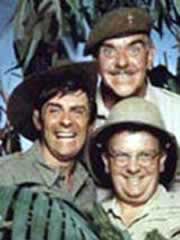

Whilst the great British public were settling back in comfortable armchairs to witness the anecdotes of David Croft and Jimmy Perry once a week, a new breed of comedy writers were climbing, ever so quietly up the ranks..
John Esmonde and Bob Larbey may not have names that are easy to roll off one’s tongue and perhaps aren’t as well known to the average brain as their counterparts, Croft and Perry, yet I will wager you that you know of at least one of their credible comedy moments. After finding their feet through the airwaves writing quick fire sketches for the BBC’s Home Service programme, ‘I’m Sorry I’ll Read That Again,’ from 1964, it was to feature budding stars as pre Python, John Cleese and future Goodies; Brooke-Taylor, Garden and Oddie. They decided that their writing partnership could take on better scope in the world of television. Writing the class shifting comedy, ‘Please Sir!,’ in 1968, their next big success was to in be 1975 when they wrote, practically side by side, the Air Force cadet comedy, ‘Get Some In,’ starring Robert Lindsay, but the more memorable of the two, was the middle class, suburban story, ‘The Good Life.’
Charting the highs and lows of a childless couple in middle class Surbiton, pushing away from the comfortable, corporate world of nine to five, it seemed the perfect idea to produce a comedy through social acceptance and class barriers. Sounding more like a Sociology lesson, this show set out to prove, if anything, the world of money and status wrong. Esmonde and Larbey had already tackled the boundaries of the class system in a class atmosphere (if you pardon the pun) in ‘Please Sir!,’ when bumbling, well educated John Alderton finds himself being taught rather than being teacher to a class full of working class South London school. If you could possibly take your eyes away from the fact that the average age of the actors playing the parts of the kids was around thirty, the show seemed much less harmless than originally thought. Thus, the writing duo became known within the walls of the BBC, to write gentle, easy going comedies which didn’t ask in return for depth of thought from it’s viewers.
It’s four key characters were names who were not known the trained television eye. The head of the team, the enthusiastic, Richard Briers, presented us with the idealist, Tom Good. Briers had played minor roles in television since the mid Sixties and trained at RADA. Finding an edge for theatre, he would spent most of his career successfully finding his way to tread the boards. Setting Tom up with an equally enthusiastic wife first came in the shape of serious supporting actress, Hannah Gordon. Turning the job down, next in line was unknown Felicity Kendal, still waiting for her break into television. Chirpy, pretty and young enough to be Barbara Good, she got the part - a role which was to be her most noted through her entire career.
Next came the job of casting the social climbing neighbours. Originally scripted to be only minor supporting roles, it appeared to Esmonde and Larbey that the relationship between the Goods and the Leadbetters, (Margo and Jerry next door) was just as significant as the actual plot line. The elegant housewife with no sense of humour, Margo went to experienced actress in TV and stage, Penelope Keith and long suffering, middle management employee went to repertory trained, Paul Eddington.
Dusting off his suit for the last time, Tom Good hangs up his nine to five image on his 40th birthday, leaving behind all the comforts that his money had given him. Keeping hold of the beautiful house in Surbiton (the show was not actually filmed in Surbiton at all,) he decides on a life of self sufficiency with his wife, Barbara. Selling the car and buying a pig and a goat, they set about growing crops in their semi detached back garden much to the disgust of their neighbours. Whilst Jerry feels it a capital idea and praises Tom in various occasions, his wife, Margo is appalled and makes no quibble in saying so. A social animal, Margo fills her days at home with the Women’s Institute and local amateur dramatics, for which she is keen, to act herself. The general joke is on Margo most of the time, where upon, she finds herself fin situations of mud and muck out of the goodness of her helping heart. She finds comfort in her friendship with pig tailed, Barbara who behaves ten years Tom’s junior at times, and often cries on Barbara’s shoulder. Though it is apparent that Jerry fancies the young, mucky faced Barbara in her dungarees and wellies, he only admires her from afar. At the same time, it is humorously apparent that Tom finds the upper class, hockey club girl, Margo just as attractive in her flowing Seventies dresses and bouffant hair. A subtle under current in the show, these attractions only come to the surface in an episode where the four taste Tom’s home made wine.
Not so much a show featuring self contained plots, the gags are minor and run gently through the entire series like a steady stream. The laughter is brought upon through the relationships between the couples, both experiencing the same neighbourhood, yet worlds apart in their lifestyles. As Tom, on occasions is almost persuaded to return to his mediocre office employment by the well meaning, Jerry, he never buckles. Very rarely showing strain from his new found life change, he still holds a certain arrogance at the supposedly automatic appraisal from his suffering wife. Trying her hand at everything including making their clothes, Barbara is a character who has found herself in a situation she would have preferred not to embark on. Missing her little luxuries, she puts these feels aside for the adoration she has for her husband - a relationship that is full of giggles and physical attraction. As opposed to Margo and Jerry, for ever proving that money doesn’t give you everything - their marriage is based on his job whilst trying to find some comfort through their flatly uninteresting hobbies…
~~~~~~~~~~~~~~~~~~~~~~~~~~~~~
‘The Good Life,’ appeared to be of the same inoffensive quality which gave it’s audience the ability to laugh at a system rather than themselves. Mixing the audiences on a physical scale, it’s appeal was felt by both sides of the pay packet. This was a barrier uncrossed through British comedy in previous years. Since the only shows that may have come close before, used the cunning disguise of the generation gap to hide the social point being made. ‘The Good Life,’ thus, found itself on the map of social good nature.
Larbey and Esmonde also found the key to good humour where perhaps the afore mentioned, Croft and Perry had failed. ‘The Good Life,’ like the rest of the Larbey and Esmonde list, only ran for short runs. ‘The Good Life,’ in itself, only ran for four series‘. Since Croft and Perry had, had their share of criticism for letting a show run for two years longer than it should, the smaller writers, won fairer hearts through shorter shows. Hence, ‘The Good Life,’ ceased after only 30 episodes.
The genuine appeal to the show was the good natured approach to snobbery on one side of the fence and muck and penniless pride on the other. Although the Good’s slum into poverty is totally through choice, it appears to be acceptable. We do still wonder, how on Earth the Good’s still manage to pay their mortgage when Tom sees no qualms with bartering with the local Gas board with some home grown potatoes to pay a bill. Yet to this couple who have still managed to keep their social novelty, their class rank is still very much in tact. Perhaps giving the rest of society’s self building sufficiency a clean break from stereotypical mockery, ‘The Good Life,’ provided a warm, peace offering to such people and handed back their dignity. If Tom and Barbara can achieve it in middle class Surrey, then it’s okay to wash clothes in the sink and eat everything from the garden.
However sensational the idea may have been, I can almost guarantee there is no one living such a lifestyle in Surbiton today. That may have something to do with the fact that you have got to be earning in excess of forty grand a year to live their in the first place (my brother does), yet this idealism leaves a warm feeling in the soul and tragically, it is now that we find this show dated. It was on it’s time and although it wasn’t truly historic like most shows created by Croft and Perry, it still gives the viewer the realisation that a life style such as this could only have been remotely possible in Surbiton, some thirty years ago. It is the general cost of living today that makes the epitome of ‘The Good Life,’ so inexcusable. So there, it is left in the decade when it could have been possible…
A special episode was performed in front of Her Majesty, The Queen and The Duke Of Edinburgh. Noted as being one of her favourite shows, the Duke may have only liked it for Felicity Kendal in wellies and bunches…
©m duffy 2007.
Wednesday, August 22, 2007
Roll Up Your Sleeves For A Taste Of The Good Life
Posted by
Michelle Duffy
at
Wednesday, August 22, 2007
0
comments
![]()
Saturday, August 04, 2007
Ode To A Writer....
Scribbling, writing, hoping.
Screwing, binning, shredding.
Sending, submitting, praying.
Watching, wishing, waiting.
Receiving, exacting, thumping.
Elated, ecstatic, published.
I sit, turn on and the buzz beings to smell,
With flexed fingers, I move my mouse and click,
The whining hum of tower and delightful warmth-
From computer - turning, working it's magic,
I surf with generous ease....
©m.duffy 2007
Posted by
Michelle Duffy
at
Saturday, August 04, 2007
0
comments
![]()
Subscribe to:
Posts (Atom)





